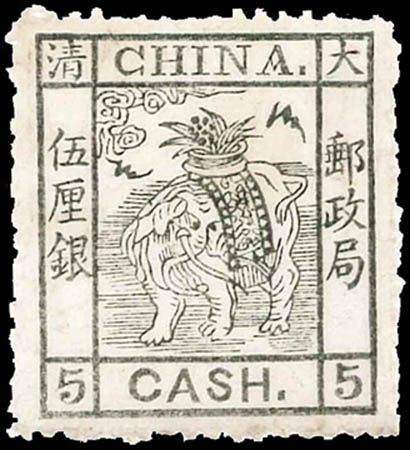By: Interasia Auctions Limited
lot # 24 - China large dragons
China, Essay of "Elephant" Design : Plate proof of 5 cash black on thin native laid paper, rough perforation 12½, excellent colour and sharp impression on this delicate paper which has remarkably retained its overall freshness, well centred with intact perforations, very fine state of conservation for this rare and elusive essay.
Estimate HK$ 150,000 - 200,000
Provenance: Peter Holcombe
Mary Ann Owens
Auction Record
George Alevizos (Santa Monica), 20.12.79, lot 493
Originally offered as a block of six and later split into a block of four and two singles by Peter Holcombe.
The above example is the lower right stamp of the original block of six. The block of four was in the Anna-Lisa and Sven-Eric Beckeman, and Lam Man Yin collections, and was recently sold by Interasia (31.7.10, lot 1). The top right single from the original block of six was formally in the collection of Henry Moser of Meilin, Switzerland, which was sold in June 2000.
References: Jeffrey S. Schneider, "Plating the Elephant Essay", Journal of China Philately, Vol. 1 (2006). pp. 262-266.
Dr. Ji Sun, "The Elephant Essay Resurfaces after 100 Years," The China Clipper, Vol. 74, No. 6 (June, 2008), pp. 231-233.
THIS MAGNIFICENT EXAMPLE IS POSITION [95] IN THE SHEET OF ONE HUNDRED.
From our records of multiples, we have reconstructed a left sheet margin block of fifty (10 x 5) from blocks of twenty-five, fifteen, six and four. These represent the bottom half of the sheet of one hundred. The blocks of fifteen and six were subsequently split into lesser multiples and singles. We have no record of any examples which do not emanate from these blocks.The Elephant design for the 5 cash stamp was one of several different subjects submitted for the first postage stamp of China in 1877-1878. It depicted a ceremonial elephant carrying a pot of growing cycas on its back. These plants characterise perpetual change and constant regeneration, which are two of the fundamental philosophies of Buddhism. The two bats flying above the elephant are also of symbolic importance. The Chinese for bat is "fu", which is the same sound as the word for happiness, while sounds for the other symbols depicted have double meanings, all of which signify "an augury of great happiness equaling Heaven" (Sir Percival David, The London Philatelist, Vol. LVIII, No.676, p. 34). Apparently, this design merited serious consideration, since the production of this proposed stamp went through five separate stages.
Research indicates that these essays were printed in a sheet of one hundred, of which only fifty examples have survived.
E
InterAsia Auctions
InterAsia Auctions' principals bring a tradition of excellence, expertise and client service, unrivalled in China and Asian philately.
Read More











